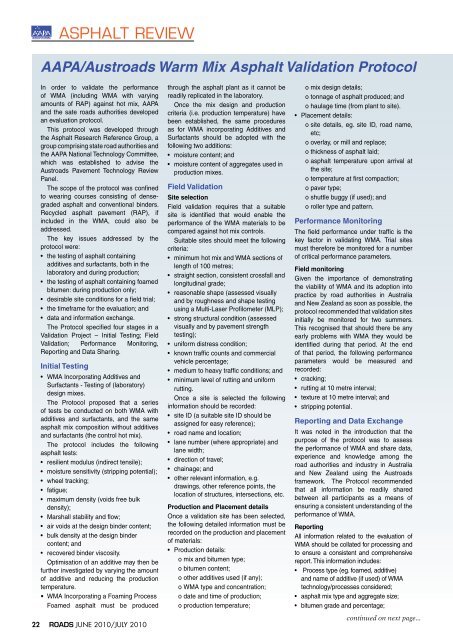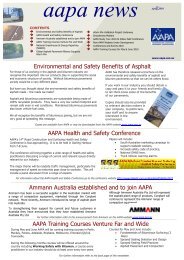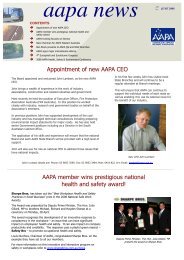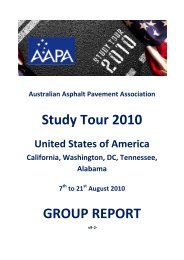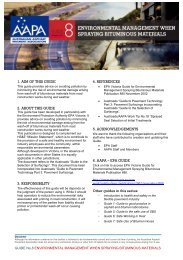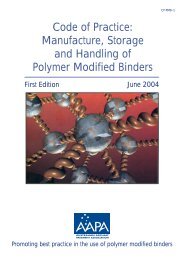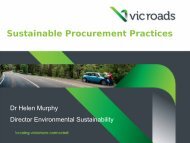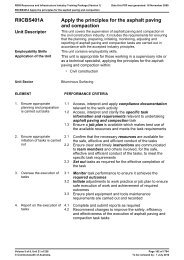Asphalt Review - Volume 29 Number 2 (June / July 2010)
Asphalt Review - Volume 29 Number 2 (June / July 2010)
Asphalt Review - Volume 29 Number 2 (June / July 2010)
You also want an ePaper? Increase the reach of your titles
YUMPU automatically turns print PDFs into web optimized ePapers that Google loves.
ASPHALT REVIEW<br />
AAPA/Austroads Warm Mix <strong>Asphalt</strong> Validation Protocol<br />
In order to validate the performance<br />
of WMA (including WMA with varying<br />
amounts of RAP) against hot mix, AAPA<br />
and the sate roads authorities developed<br />
an evaluation protocol.<br />
This protocol was developed through<br />
the <strong>Asphalt</strong> Research Reference Group, a<br />
group comprising state road authorities and<br />
the AAPA National Technology Committee,<br />
which was established to advise the<br />
Austroads Pavement Technology <strong>Review</strong><br />
Panel.<br />
The scope of the protocol was confined<br />
to wearing courses consisting of densegraded<br />
asphalt and conventional binders.<br />
Recycled asphalt pavement (RAP), if<br />
included in the WMA, could also be<br />
addressed.<br />
The key issues addressed by the<br />
protocol were:<br />
• the testing of asphalt containing<br />
additives and surfactants, both in the<br />
laboratory and during production;<br />
• the testing of asphalt containing foamed<br />
bitumen: during production only;<br />
• desirable site conditions for a field trial;<br />
• the timeframe for the evaluation; and<br />
• data and information exchange.<br />
The Protocol specified four stages in a<br />
Validation Project – Initial Testing; Field<br />
Validation; Performance Monitoring,<br />
Reporting and Data Sharing.<br />
Initial Testing<br />
• WMA Incorporating Additives and<br />
Surfactants - Testing of (laboratory)<br />
design mixes.<br />
The Protocol proposed that a series<br />
of tests be conducted on both WMA with<br />
additives and surfactants, and the same<br />
asphalt mix composition without additives<br />
and surfactants (the control hot mix).<br />
The protocol includes the following<br />
asphalt tests:<br />
• resilient modulus (indirect tensile);<br />
• moisture sensitivity (stripping potential);<br />
• wheel tracking;<br />
• fatigue;<br />
• maximum density (voids free bulk<br />
density);<br />
• Marshall stability and flow;<br />
• air voids at the design binder content;<br />
• bulk density at the design binder<br />
content; and<br />
• recovered binder viscosity.<br />
Optimisation of an additive may then be<br />
further investigated by varying the amount<br />
of additive and reducing the production<br />
temperature.<br />
• WMA Incorporating a Foaming Process<br />
Foamed asphalt must be produced<br />
22 ROADS JUNE <strong>2010</strong>/JULY <strong>2010</strong><br />
through the asphalt plant as it cannot be<br />
readily replicated in the laboratory.<br />
Once the mix design and production<br />
criteria (i.e. production temperature) have<br />
been established, the same procedures<br />
as for WMA incorporating Additives and<br />
Surfactants should be adopted with the<br />
following two additions:<br />
• moisture content; and<br />
• moisture content of aggregates used in<br />
production mixes.<br />
Field Validation<br />
Site selection<br />
Field validation requires that a suitable<br />
site is identified that would enable the<br />
performance of the WMA materials to be<br />
compared against hot mix controls.<br />
Suitable sites should meet the following<br />
criteria:<br />
• minimum hot mix and WMA sections of<br />
length of 100 metres;<br />
• straight section, consistent crossfall and<br />
longitudinal grade;<br />
• reasonable shape (assessed visually<br />
and by roughness and shape testing<br />
using a Multi-Laser Profilometer (MLP);<br />
• strong structural condition (assessed<br />
visually and by pavement strength<br />
testing);<br />
• uniform distress condition;<br />
• known traffic counts and commercial<br />
vehicle percentage;<br />
• medium to heavy traffic conditions; and<br />
• minimum level of rutting and uniform<br />
rutting.<br />
Once a site is selected the following<br />
information should be recorded:<br />
• site ID (a suitable site ID should be<br />
assigned for easy reference);<br />
• road name and location;<br />
• lane number (where appropriate) and<br />
lane width;<br />
• direction of travel;<br />
• chainage; and<br />
• other relevant information, e.g.<br />
drawings, other reference points, the<br />
location of structures, intersections, etc.<br />
Production and Placement details<br />
Once a validation site has been selected,<br />
the following detailed information must be<br />
recorded on the production and placement<br />
of materials:<br />
• Production details:<br />
o mix and bitumen type;<br />
o bitumen content;<br />
o other additives used (if any);<br />
o WMA type and concentration;<br />
o date and time of production;<br />
o production temperature;<br />
o mix design details;<br />
o tonnage of asphalt produced; and<br />
o haulage time (from plant to site).<br />
• Placement details:<br />
o site details, eg. site ID, road name,<br />
etc;<br />
o overlay, or mill and replace;<br />
o thickness of asphalt laid;<br />
o asphalt temperature upon arrival at<br />
the site;<br />
o temperature at first compaction;<br />
o paver type;<br />
o shuttle buggy (if used); and<br />
o roller type and pattern.<br />
Performance Monitoring<br />
The field performance under traffic is the<br />
key factor in validating WMA. Trial sites<br />
must therefore be monitored for a number<br />
of critical performance parameters.<br />
Field monitoring<br />
Given the importance of demonstrating<br />
the viability of WMA and its adoption into<br />
practice by road authorities in Australia<br />
and New Zealand as soon as possible, the<br />
protocol recommended that validation sites<br />
initially be monitored for two summers.<br />
This recognised that should there be any<br />
early problems with WMA they would be<br />
identified during that period. At the end<br />
of that period, the following performance<br />
parameters would be measured and<br />
recorded:<br />
• cracking;<br />
• rutting at 10 metre interval;<br />
• texture at 10 metre interval; and<br />
• stripping potential.<br />
Reporting and Data Exchange<br />
It was noted in the introduction that the<br />
purpose of the protocol was to assess<br />
the performance of WMA and share data,<br />
experience and knowledge among the<br />
road authorities and industry in Australia<br />
and New Zealand using the Austroads<br />
framework. The Protocol recommended<br />
that all information be readily shared<br />
between all participants as a means of<br />
ensuring a consistent understanding of the<br />
performance of WMA.<br />
Reporting<br />
All information related to the evaluation of<br />
WMA should be collated for processing and<br />
to ensure a consistent and comprehensive<br />
report. This information includes:<br />
• Process type (eg. foamed, additive)<br />
and name of additive (if used) of WMA<br />
technology/processes considered;<br />
• asphalt mix type and aggregate size;<br />
• bitumen grade and percentage;<br />
continued on next page...


